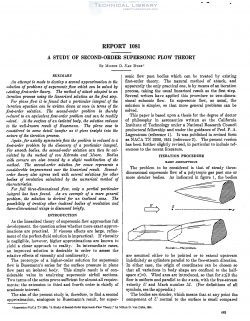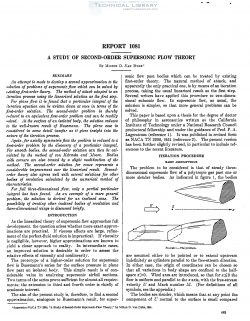naca-report-1081

- Version
- 206 Downloads
- 2.86 MB File Size
- 1 File Count
- September 7, 2016 Create Date
- September 7, 2016 Last Updated
National Advisory Committee for Aeronautics, Report - A Study of Second Order Supersonic Flow Theory

An attempt is made to decelop a second approximation to the
solution of problems of supersonic flow which can be salted by
ecistingfirst-order theory. The method of attack adopted is an
iteration process using the linearized solution as the first step.
For plane flow it is found that a particular integral of the
iteration equation can be written down at once in terms of the
first-order solution. The second-order problem is thereby
reduced to an equivalent first—order problem and can be readily
mlred. At the surface of an isolated body, the solution reduces
to the ufell—lcnoum result of Busemann. The plane case is
considered in some detail insofar as it gires insight into the
nature of the iteration process.
Again, for axially symmetric flow the problem is reduced to a
first—order problem by the discorery of a particular integral.
For smooth bodies, the second-order solution can then be cal-
culated by the method of con Kdrmdn and JIoore. Bodies
with corners are also treated by a slight modification of the
method. The second-order solution for cones represents a
considerable improrement over the linearized result. Second—
order theory also agrees well with screral solutions for other
bodies of rerolution calculated by the numerical method of
characteristics.
For full three-dimensional flout, only a partial particular
integral has been found. As an example of a more general
problem, the solution is derived for an inclined cone. The
possibility of treating other inclined bodies of revolution and
three-dimensional u‘ings is discussed briefly.
As the linearized theory of supersonic flow approaches full
development. the question arises whether more exact approx-
imations are practical. If viscous efi‘ects are large. refine-
ment of the perfect-fluid solution is impractical. If viscosity
is negligible, however, higher approximations are known to
yield a closer approach to reality. In intermediate cases,
an improved solution is desirable in order to assess the
relative effects of viscosity and nonlinearity.
| File | Action |
|---|---|
| naca-report-1081 A Study of Second Order Supersonic Flow Theory.pdf | Download |

Comment On This Post